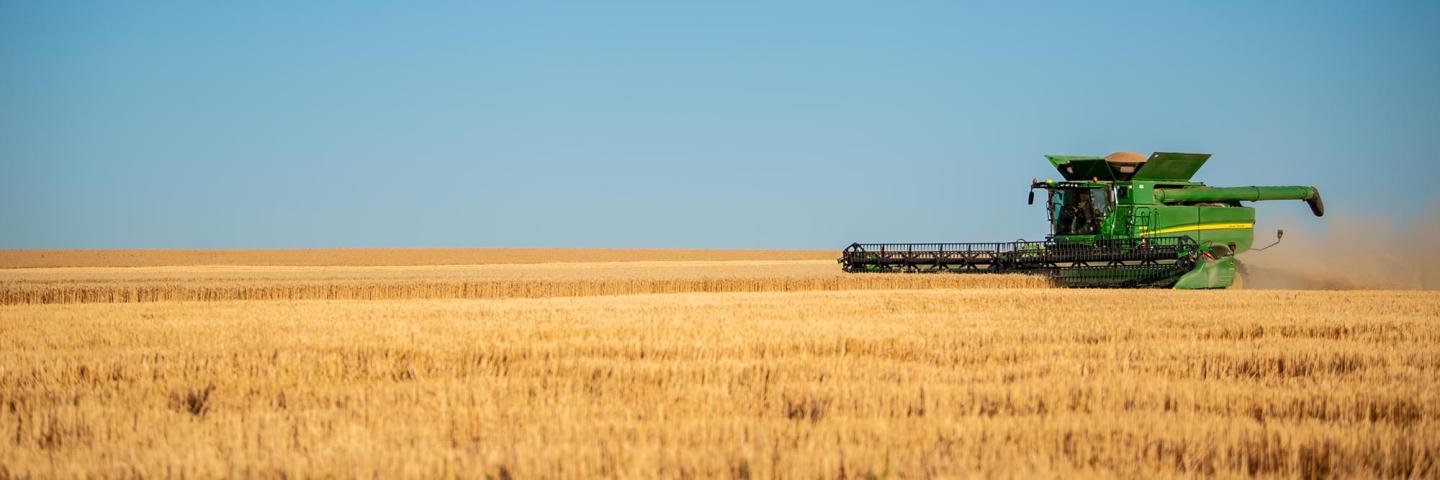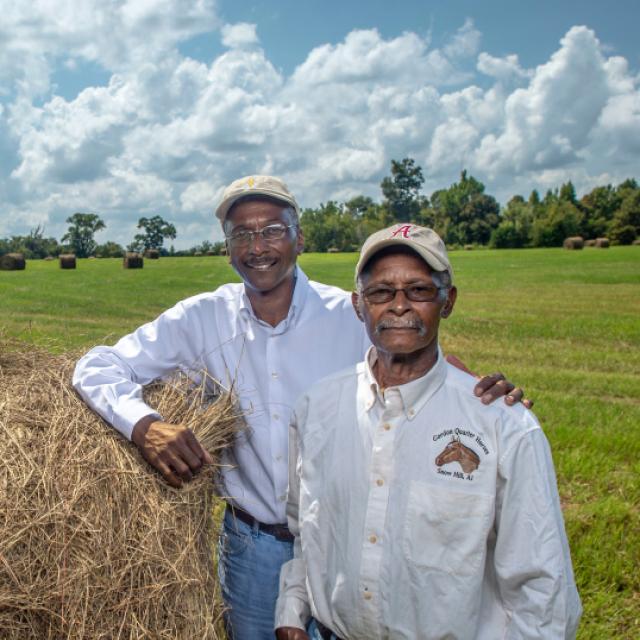EQIP CPAs, DIAs, and CEMAs
Learn about EQIP Conservation Planning Activities (CPAs), Design and Implementation Activities (DIAs), and Conservation Evaluation and Monitoring Activities (CEMAs).

The Environmental Quality Incentives Program (EQIP) is NRCS’ flagship conservation program that helps farmers, ranchers and forest landowners integrate conservation into working lands.
NRCS works one-on-one with producers to develop a conservation plan that outlines conservation practices and activities to help solve on-farm resource issues. Producers implement practices and activities in their conservation plan that can lead to cleaner water and air, healthier soil and better wildlife habitat, all while improving their agricultural operations. EQIP helps producers make conservation work for them. Financial assistance for practices may be available through EQIP. Some producers may also qualify for advance payment.
Some of these benefits include:
Watch how farmers and ranchers across the country are implementing EQIP practices and other conservation activities in our Conservation at Work video series. For example, see how producers are using the nutrient management conservation practice to improve water quality by more effectively using nutrients.
Targeted EQIP financial assistance is available through several conservation initiatives. See which initiative is available in your state.
EQIP offers grant opportunities through Conservation Innovation Grants, which awards competitive grants that stimulate the development and adoption of innovative approaches and technologies for conservation on agricultural lands.
NRCS offers technical assistance at no cost. Producers can use our personalized advice and information, based on the latest science and research, to make informed decisions about their land.
Technical Service Providers (TSP) can help producers plan, design and implement conservation practices or develop conservation activity plans to improve their agricultural operations. For more information on the Technical Service Provider program, visit the TSP page.
Technical assistance is also offered through our Conservation Technical Assistance (CTA) program.
Need a local Technical Service Provider? Visit the locate a TSP page.
The first step is to contact your local NRCS office. An NRCS conservation planner will schedule a visit to your property. They will walk the land with you to discuss your goals and review any resource concerns. Following the site visit, the conservation planner will develop a conservation plan that includes a variety of conservation practices or activities to address the resource concerns and management goals discussed.
Applications for NRCS conservation programs are accepted on a continuous basis; however, customers should apply by state-specific ranking dates to be considered for the current funding cycle.
To learn more about EQIP, contact your local NRCS office.
NRCS program data are housed on the Resource Conservation Assessment Data Viewer. EQIP data for FY2009 to the present are available on the EQIP data page. Fiscal year 2014 - 2021 financial assistance data related to EQIP and other NRCS programs are available on farmers.gov.
EQIP applications are accepted at any time of the year. Applications received by the application deadline are evaluated for funding if the applicants have completed the eligibility requirements.
The first application deadline for FY 2026 funding consideration is October 17, 2025.
This application deadline applies to the following:
Although applications are accepted on a year-round basis, only applications received by October 17, 2025, will be considered for funding this fiscal year for projects where the majority of the land is located in New Mexico.
All other conservation programs offered through NRCS New Mexico will be announced later.
The Environmental Quality Incentives Program (EQIP) is a voluntary program authorized under the Agricultural Improvement ACT of 2018 (2018 Farm Bill) that helps producers install measures to protect soil, water, plant, wildlife, and other natural resources while ensuring sustainable production on their farms, ranches and working forest lands. In addition, a purpose of EQIP is to help producers meet Federal, State, Tribal and local environmental regulations. The Natural Resources Conservation Service (NRCS) administers EQIP funding and provides participants with professional conservation expertise.
Payments are made to participants after conservation practices and activities identified in an EQIP plan of operations are implemented. Contracts can last up to ten years in duration. Each EQIP contract with a person or legal entity will be limited to $450,000 over the term of the contract. A person or legal entity may not receive, directly or indirectly, payments that, in the aggregate, exceed $450,000 for all 2018 Farm Bill contracts entered into during fiscal years 2019. Payments received for technical assistance are excluded from this limitation.
The State Conservationist, with advice from the State Technical Committee and local working groups, allocates funds to various EQIP fund accounts and develops a ranking process to addresses National, State and Local priority natural resource concerns in a cost-effective manner.
The New Mexico State Conservationist establishes state priority natural resource concerns using recommendations of the State Technical Committee and tribal Conservation advisory councils. Local Working Groups establish local priorities.
Those who submit an application and are accepted into EQIP may receive payments to offset costs associated with materials and installation of conservation practices. Practices funded through EQIP may include such measures as: manure management practices, pest management treatments, irrigation systems improvements, forest stewardship plans and management practices, erosion control and buffers, range and pasture planting, brush management, fencing, watering facilities, and a wide range of other practices.
The New Mexico list of conservation practices shows approved practices and the lifespan of each practice.
The amount of financial assistance for a conservation practice is determined by practice scenarios that identify the costs of the typical installation settings. The costs used in the scenarios are regional averages and are not intended to be used as an estimate of the actual cost to install a practice. Historically underserved participants receive 90 percent of the total cost of a scenario and all other participants receive 75 percent. These percentages are captured in the payment schedule, which in the past was referred to as a cost list.
NRCS will select the conservation practice scenario that bests addresses the resource concern at the least-cost to the government. The least-cost scenario selected in an EQIP contract does not limit the choice of treatment options of the participant. However, the treatment option implemented must meet NRCS standards and specifications, address the identified resource concern, and be approved by an individual with NRCS job approval authority.
The practices funded by EQIP varies by EQIP fund account.
EQIP applications are evaluated and ranked for available funding based on local, state and national program priorities. Screening tools may also be used to manage workload and identify projects that will provide the most environmental benefits. All NRCS programs will utilize CART for assessing and ranking all applications received during the announced sign-up or batching periods to determine funding. The Conservation Assessment Ranking Tool (CART) is the agency’s official application used to assist conservation planners to assess site vulnerability, existing field conditions, and potential resource concerns on a unit of land. The local Field Office collects information about the applicants’ agricultural operations through existing information, on-site visits, and/or personal communications and works with the applicant to develop an EQIP Conservation Plan/Schedule of Operations. The information collected is used to assess and rank the application which results in a numerical score. Applicants compete for available EQIP funds within a specific fund account, such as irrigated crop or grazed range or forested land, etc. Applications are selected for funding in the order of screening priority and highest-ranking score. Applications may be ranked throughout the year as long as funds are available.
Screening and ranking criteria are developed separately for each EQIP fund account.
Applicants can request to be considered in all applicable fund accounts or can specify that their application be considered in just certain fund accounts.
Please direct all questions about applying for EQIP to your local office.
Kenneth J. Branch
Assistant State Conservationist for Programs
(505) 761-4454 voice
(855) 538-6003 fax
E-mail: kenneth.branch@usda.gov
The Environmental Quality Incentives Program (EQIP) provides financial and technical assistance to agricultural producers and non-industrial forest managers.
Learn MoreThe 2018 Farm Bill was enacted on December 20, 2018. The Farm Bill continues its strong support for conservation efforts of America’s farmers and ranchers through reauthorization and expanded flexibility of NRCS conservation programs.
Learn MoreContact your local service center to start your application.
Do you farm or ranch and want to make improvements to the land that you own or lease?
Natural Resources Conservation Service offers technical and financial assistance to help farmers, ranchers and forest landowners.

To get started with NRCS, we recommend you stop by your local NRCS field office. We’ll discuss your vision for your land.
NRCS provides landowners with free technical assistance, or advice, for their land. Common technical assistance includes: resource assessment, practice design and resource monitoring. Your conservation planner will help you determine if financial assistance is right for you.
We’ll walk you through the application process. To get started on applying for financial assistance, we’ll work with you:
Once complete, we’ll work with you on the application, or CPA 1200.
Applications for most programs are accepted on a continuous basis, but they’re considered for funding in different ranking periods. Be sure to ask your local NRCS district conservationist about the deadline for the ranking period to ensure you turn in your application in time.
As part of the application process, we’ll check to see if you are eligible. To do this, you’ll need to bring:
If you don’t have a farm number, you can get one from USDA’s Farm Service Agency. Typically, the local FSA office is located in the same building as the local NRCS office. You only need a farm number if you’re interested in financial assistance.
NRCS will take a look at the applications and rank them according to local resource concerns, the amount of conservation benefits the work will provide and the needs of applicants. View Application Ranking Dates by State.
If you’re selected, you can choose whether to sign the contract for the work to be done.
Once you sign the contract, you’ll be provided standards and specifications for completing the practice or practices, and then you will have a specified amount of time to implement. Once the work is implemented and inspected, you’ll be paid the rate of compensation for the work if it meets NRCS standards and specifications.